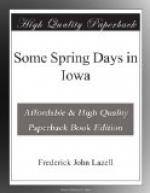Another interesting plant is the trillium erectum, which with the trillium recurvatum, is now to be found in the woods hereabouts. The flowers of the trillium erectum are ill scented, carrion scented, if you please. Now the botanists have found that this odor, which is so unpleasant to the human nostrils, does the plant a real service by attracting the common green flesh-flies, such as are seen in the butchershops in the summer-time. They eat the pollen, which is supposed to taste as it smells and thus as they go from flower to flower they carry pollen from one blossom to another and so secure for the plant cross-pollination.
So we may walk from one flower to another until the morning wears to a bright noon and the afternoon wanes into a songful sunset.
* * * * *
In the swamp, where the red-winged blackbird is building her bulky nest between the stems of the cat tail, and the prairie marsh wren is making her second or third little globular nest in a similar place, there is a blaze of yellow from the marsh marigolds which make masses of succulent stems and leaves, crowned with pale gold, as far up the marsh as the eye can reach. In Iowa, it is in May, rather than in June, that “the cowslip startles the meadows green” and “the buttercup catches the sun in its chalice.” And it is in late April or early May that “the robin is plastering his house hard by.” By the way, ought not the poet to have made it “her” house? It is the mother bird who seems to do the plastering. Both birds work on the structure, but it appears to be the female who carries most of the mud and who uses her faded red apron for a trowel as she moves round in her nest pushing her breast against the round wall of the adobe dwelling to spread the mud evenly. The work on one particular nest was done in late April when there was nothing on the elm but the seed fringes to screen the builder as she worked. Then the four light greenish-blue eggs were laid. A red squirrel got one of them one day. Disregarding the squeakings and scoldings of the anxious robins, he sat on a limb holding the egg in his forepaws and bit a hole in one side of it. Then he drained the contents, dropped the shell to the ground and was about to get another egg when he was driven off. Apparently he forgot the location of the nest after that, for the other three eggs hatched out safely.
* * * * *
The air is filled with bird music. It began with the larks, closely followed by the robins, and then the noise of the crows. No change in the program since the days of Shakespeare’s Troilus and Cressida when:




